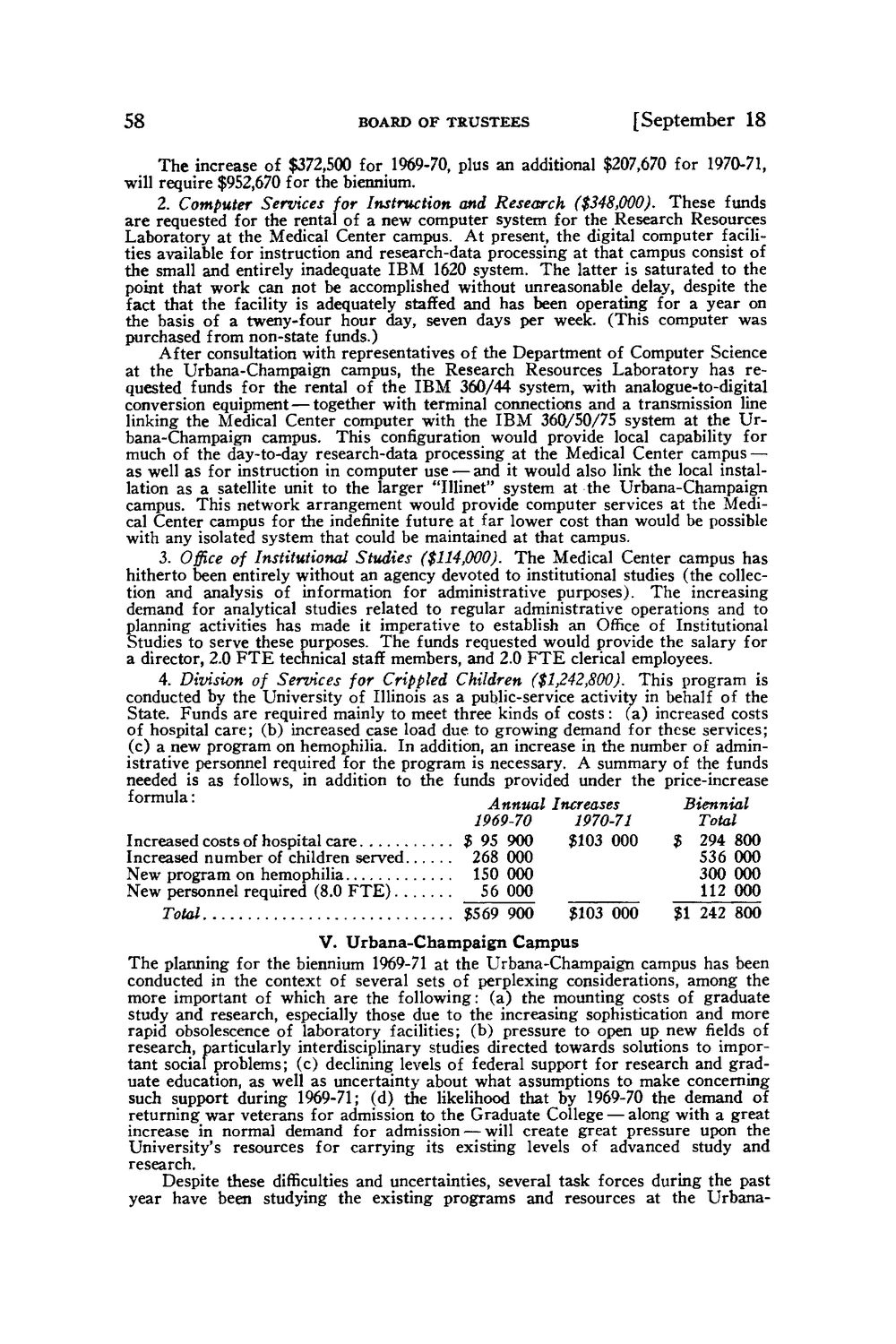| |
| |
Caption: Board of Trustees Minutes - 1970
This is a reduced-resolution page image for fast online browsing.

EXTRACTED TEXT FROM PAGE:
58 BOARD O F TRUSTEES [September 18 T h e increase of $372,500 for 1969-70, plus an additional $207,670 for 1970-71, will require $952,670 for the biennium. 2. Computer Services for Instruction and Research ($348,000). These funds are requested for the rental of a new computer system for the Research Resources Laboratory at the Medical Center campus. At present, the digital computer facilities available for instruction and research-data processing at that campus consist of the small and entirely inadequate IBM 1620 system. The latter is saturated to the point that work can not be accomplished without unreasonable^ delay, despite the fact that the facility is adequately staffed and has been operating for a year on the basis of a tweny-four hour day, seven days per week. (This computer was purchased from non-state funds.) After consultation with representatives of the Department of Computer Science at the Urbana-Champaign campus, the Research Resources Laboratory has requested funds for the rental of the I B M 360/44 system, with analogue-to-digital conversion equipment — together with terminal connections and a transmission line linking the Medical Center computer with the I B M 360/50/75 system at the U r bana-Champaign campus. This configuration would provide local capability for much of the day-to-day research-data processing at the Medical Center campus — as well as for instruction in computer use — and it would also link the local installation as a satellite unit to the larger "Illinet" system at the Urbana-Champaign campus. This network arrangement would provide computer services at the Medical Center campus for the indefinite future at far lower cost than would be possible with any isolated system that could be maintained at that campus. 3. Office of Institutional Studies ($114,000). The Medical Center campus has hitherto been entirely without an agency devoted to institutional studies (the collection and analysis of information for administrative purposes). The increasing demand for analytical studies related to regular administrative operations and to planning activities has made it imperative to establish an Office of Institutional Studies to serve these purposes. The funds requested would provide the salary for a director, 2.0 F T E technical staff members, and 2.0 F T E clerical employees. 4. Division of Services for Crippled Children ($1,242,800). This program is conducted by the University of Illinois as a public-service activity in behalf of the State. Funds are required mainly to meet three kinds of costs: (a) increased costs of hospital care; (b) increased case load due to growing demand for these services; (c) a new program on hemophilia. In addition, an increase in the number of administrative personnel required for the program is necessary. A summary of the funds needed is as follows, in addition to the funds provided under the price-increase formula: Increased costs of hospital care Increased number of children served New program on hemophilia New personnel required (8.0 F T E ) Total Annual 1969-70 $ 95 900 268 000 150 000 56 000 $569 900 Increases 1970-71 $103 000 $103 000 Biennial Total $ 294 800 536 000 300 000 112 000 $1 242 800 V. U r b a n a - C h a m p a i g n C a m p u s The planning for the biennium 1969-71 at the Urbana-Champaign campus has been conducted in the context of several sets of perplexing considerations, among the more important of which are the following: (a) the mounting costs of graduate study and research, especially those due to the increasing sophistication and more rapid obsolescence of laboratory facilities; (b) pressure to open up new fields of research, particularly interdisciplinary studies directed towards solutions to important social problems; (c) declining levels of federal support for research and graduate education, as well as uncertainty about what assumptions to make concerning such support during 1969-71; (d) the likelihood that by 1969-70 the demand of returning war veterans for admission to the Graduate College — along with a great increase in normal demand for admission — will create great pressure upon the University's resources for carrying its existing levels of advanced study and research. Despite these difficulties and uncertainties, several task forces during the past year have been studying the existing programs and resources at the Urbana-
| |